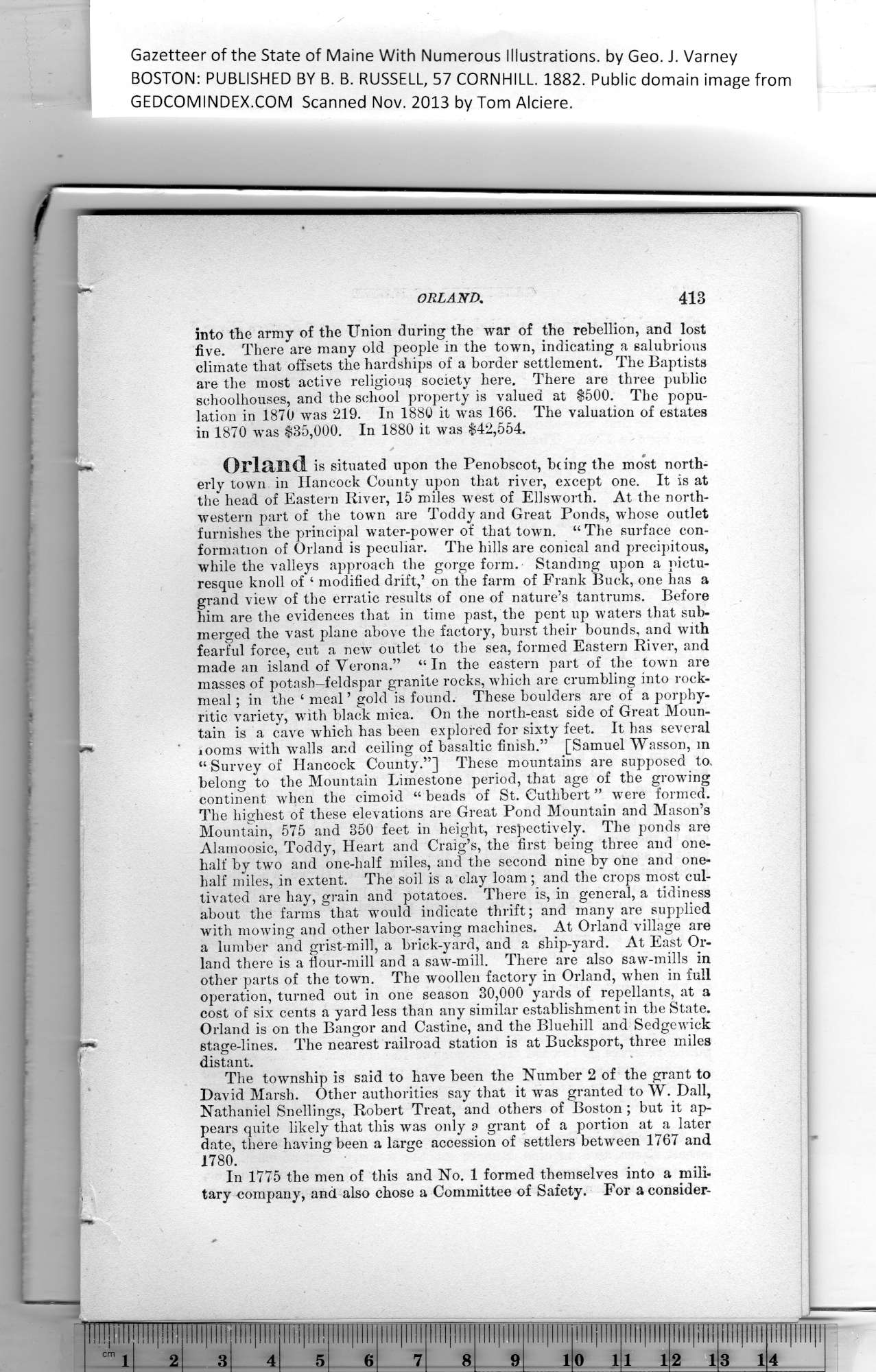|
Gazetteer of the State of Maine With Numerous Illustrations, by Geo. J. Varney
BOSTON: PUBLISHED BY B. B. RUSSELL, 57 CORNHILL. 1882. Public domain image from
ORLAND. 413
into the army of the Union during the war of the rebellion, and lost
five. There are many old people in the town, indicating a salubrious
climate that offsets the hardships of a border settlement. The Baptists
are the most active religious society here. There are three public
schoolhouses, and the school property is valued at $500. The popu-
lation in 1870 was 219. In 1880 it was 166. The valuation of estates
in 1870 was $35,000. In 1880 it was $42,554.
Orland is situated upon the Penobscot, being the most north-
erly town in Hancock County upon that river, except one. It is at
the head of Eastern River, 15 miles west of Ellsworth. At the north-
western part of the town are Toddy and Great Ponds, whose outlet
furnishes the principal water-power of that town. “ The surface con-
formation of Orland is peculiar. The hills are conical and precipitous,
while the valleys approach the gorge form. Standing upon a pictu-
resque knoll of ‘ modified drift,’ on the farm of Frank Buck, one has a
grand view of the erratic results of one of nature’s tantrums. Before
him are the evidences that in time past, the pent up waters that sub-
merged the vast plane above the factory, burst their bounds, and with
fearful force, cut a new outlet to the sea, formed Eastern River, and
made an island of Verona.” “In the eastern part of the town are
masses of potash-f eld spar granite rocks, which are crumbling into roek-
nieal; in the ‘ meal ’ gold is found. These boulders are of a porphy-
ritic variety, with black mica. On the north-east side of Great Moun-
tain is a cave which has been explored for sixty feet. It has several
100ms with walls and ceiling of basaltic finish.” [Samuel Wasson, m
“ Survey of Hancock County.”] These mountains are supposed to,
belong to the Mountain Limestone period, that age of the growing
continent when the cimoid “ beads of St. Cuthbert ” were formed.
The highest of these elevations are Great Pond Mountain and Mason’s
Mountain, 575 and 350 feet in height, respectively. The ponds are
Alamoosic, Toddy, Heart and Craig’s, the first being three and one-
half by two and one-half miles, and the second nine by one and one-
half miles, in extent. The soil is a clay loam; and the crops most cul-
tivated are hay, grain and potatoes. There is, in general, a tidiness
about the farms that would indicate thrift; and many are supplied
with mowing and other labor-saving machines. At Orland village are
a lumber and grist-mill, a brick-yard, and a ship-yard. At East Or-
land there is a flour-mill and a saw-mill. There are also saw-mills in
other parts of the town. The woollen factory in Orland, when in full
operation, turned out in one season 30,000 yards of repellants, at a
cost of six cents a yard less than any similar establishment in the State.
Orland is on tbe Bangor and Castine, and the Bluehill and Sedgewick
stage-lines. The nearest railroad station is at Bucksport, three miles
distant.
The township is said to have been the Number 2 of the grant to
David Marsh. Other authorities say that it was granted to W. Dali,
Nathaniel Snellings, Robert Treat, and others of Boston; but it ap-
pears quite likely that this was only a grant of a portion at a later
date, there having been a large accession of settlers between 1767 and
1780.
In 1775 tbe men of this and No. 1 formed themselves into a mili-
tary company, and also chose a Committee of Safety. For a consider-
PREVIOUS PAGE ... NEXT PAGE
This page was written in HTML using a program written in Python 3.2
|
